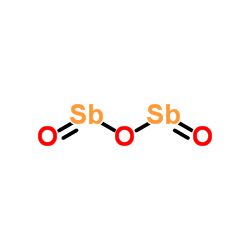Antimony-trioxide- and arsenic-trioxide-induced apoptosis in myelogenic and lymphatic cell lines, recruitment of caspases, and loss of mitochondrial membrane potential are enhanced by modulators of the cellular glutathione redox system.
Susan Lösler, Sarah Schlief, Christiane Kneifel, Eckhard Thiel, Hubert Schrezenmeier, Markus T Rojewski
Index: Ann. Hematol. 88(11) , 1047-58, (2009)
Full Text: HTML
Abstract
During the last years remission rates of more than 72% for arsenic(III)-oxide (As(2)O(3)) treatment in relapsed or refractory acute promyelocytic leukemia have been published. As(2)O(3) is under clinical investigation for therapy of leukemia and solid tumors. Due to the chemical affinity of arsenic and antimony, we analyzed the potency of antimony(III)-oxide (Sb(2)O(3)) to exert As(2)O(3)-like effects. Based on the same molar concentrations, lower efficacy in apoptosis induction and caspase-independent decrease of mitochondrial membrane potential was observed for Sb(2)O(3). No difference in sensitivity to As(2)O(3) or Sb(2)O(3) was detected in CEM cells when compared to their multiple drug resistant derivatives. Apoptosis was induced by combining sub-apoptotic concentrations of Sb(2)O(3) or As(2)O(3) with sub-apoptotic concentrations of DL: -buthionine-[S,R]-sulfoximine (BSO). Other modulators of the cellular redox system showed this effect to a lower extent and enhancement was not consistent for the different cell lines tested. Caspase inhibitors protected cell lines from Sb(2)O(3)- and As(2)O(3)-induced apoptosis. When BSO was added, the inhibitors lost their protective ability. The ability of modulators of the cellular redox system in clinically applicable concentrations to enhance the apoptotic effects of the two oxides in a synergistic way may be helpful to reduce their toxicity by optimizing their dose.
Related Compounds
| Structure | Name/CAS No. | Molecular Formula | Articles |
|---|---|---|---|
 |
Diantimony trioxide
CAS:1309-64-4 |
O3Sb2 |
|
Dermatitis in workers exposed to antimony in a melting proce...
1993-04-01 [J. Occup. Med. 35(4) , 392-5, (1993)] |
|
Characterization of pyramidal inversion boundaries in Sb2O3-...
2007-05-01 [Acta Crystallogr. A 63(Pt 3) , 229-33, (2007)] |
|
Biovolatilization of antimony and sudden infant death syndro...
1998-04-01 [Hum. Exp. Toxicol. 17(4) , 231-8, (1998)] |
|
Comparison of clastogenic effects of antimony and bismuth as...
1993-01-01 [Biol. Trace Elem. Res. 37(2-3) , 281-92, (1993)] |
|
Failure of antimony trioxide to induce micronuclei or chromo...
2007-03-05 [Mutat. Res. 627(2) , 119-28, (2007)] |